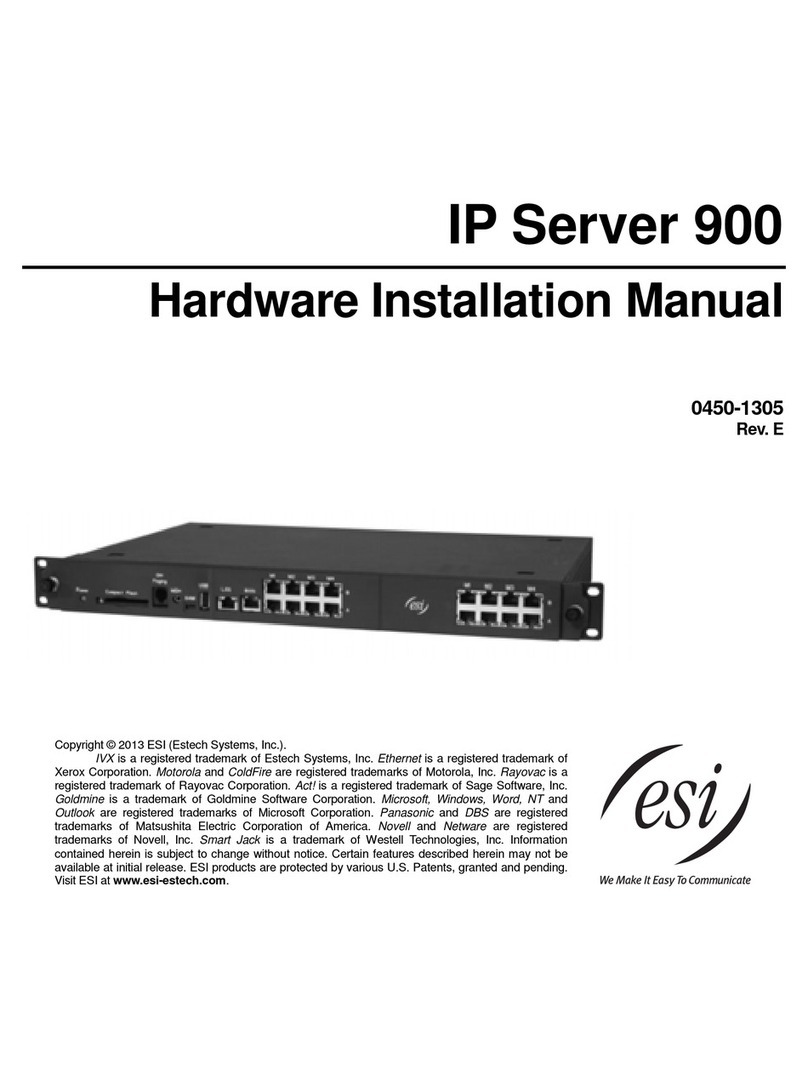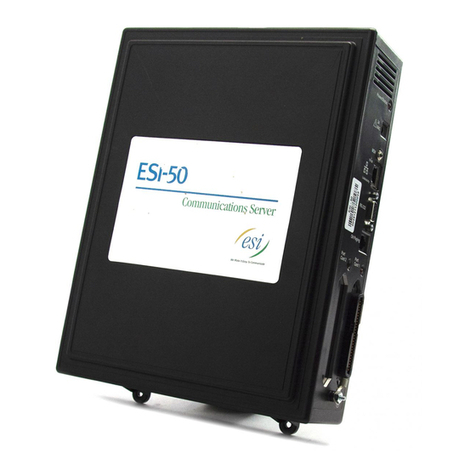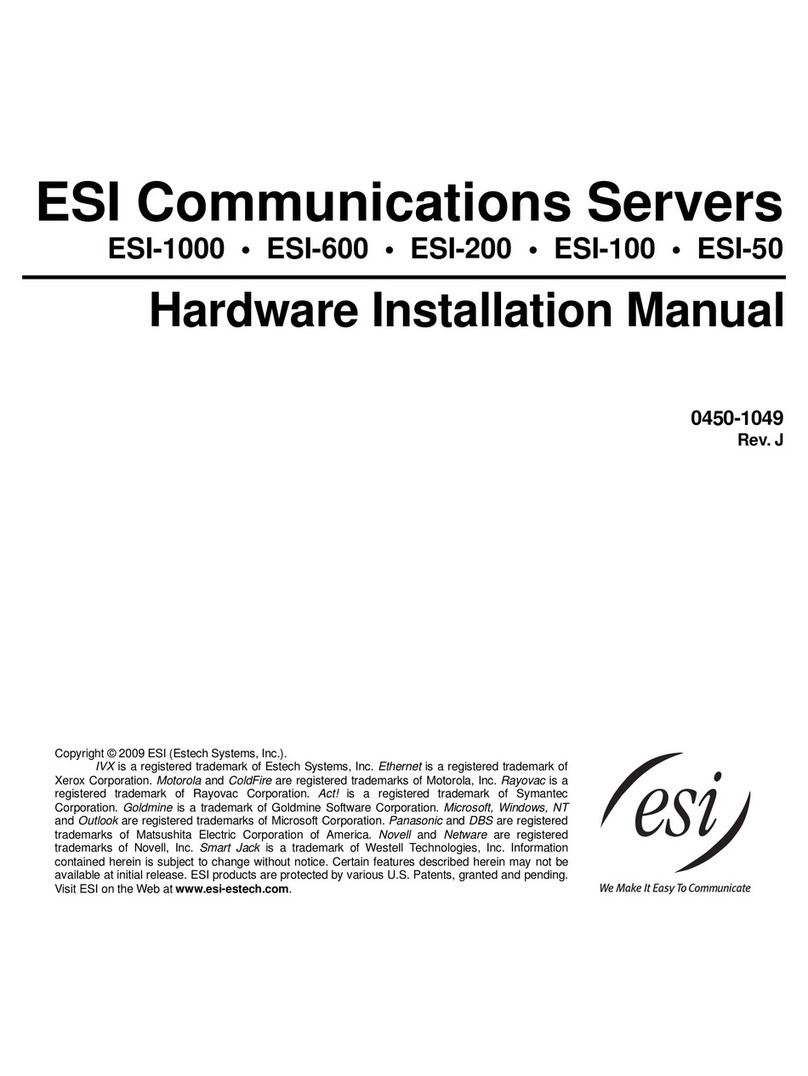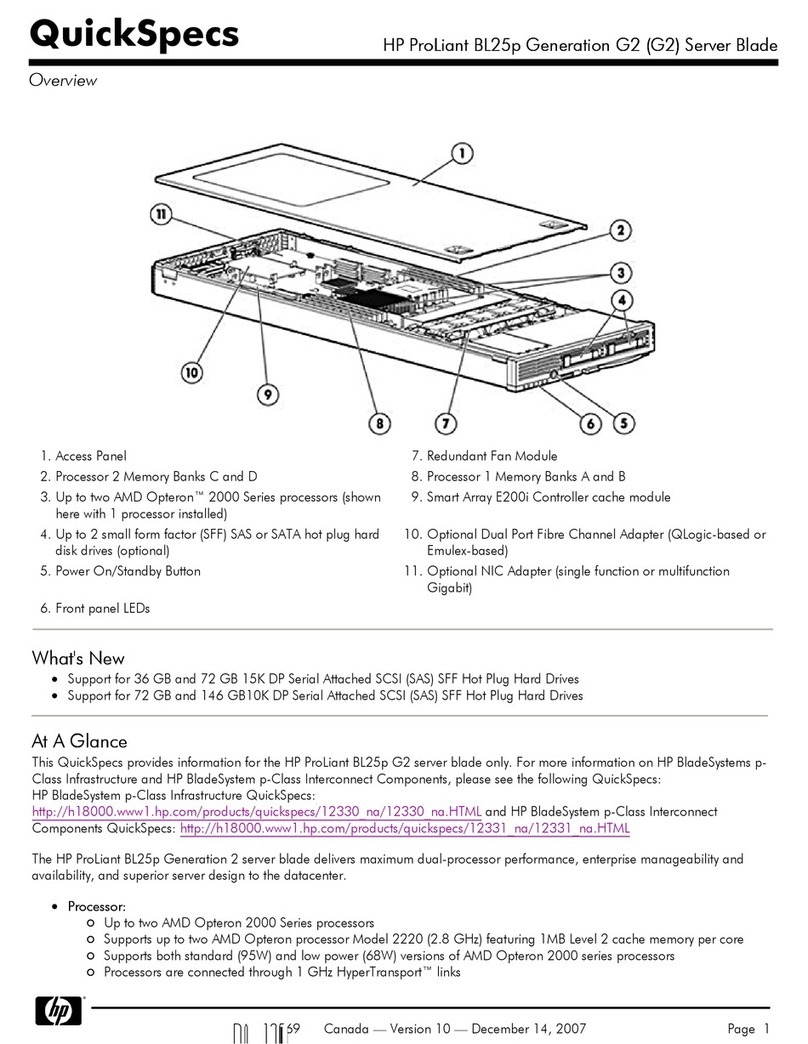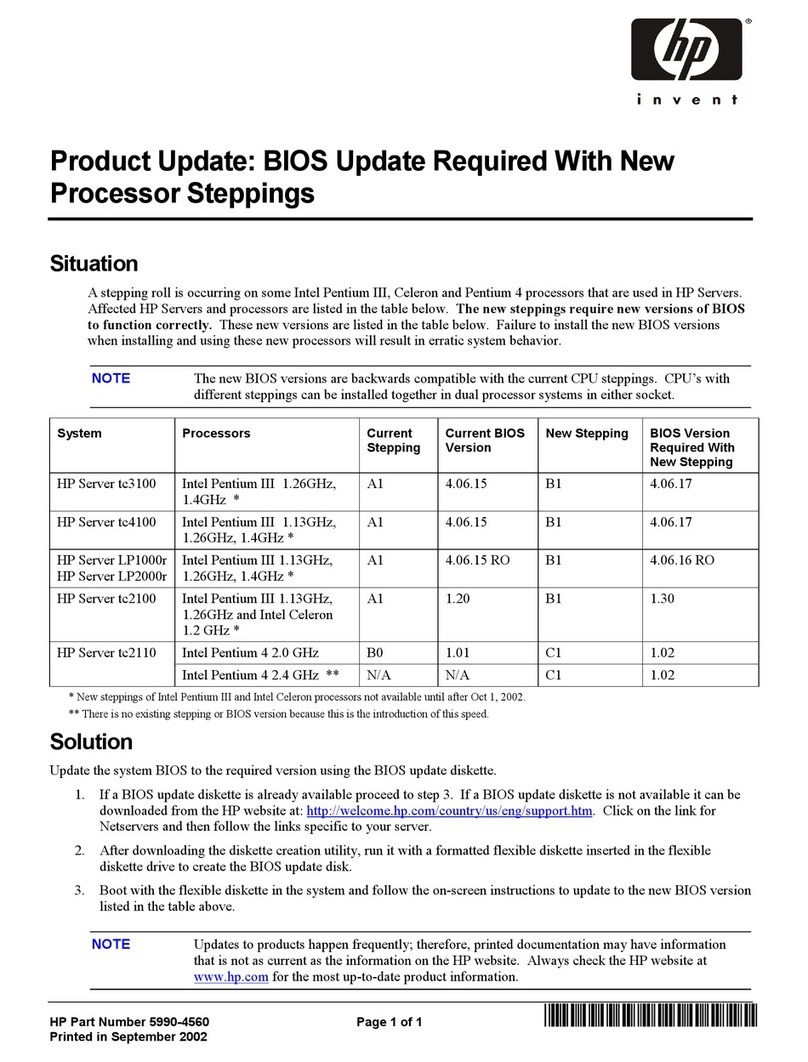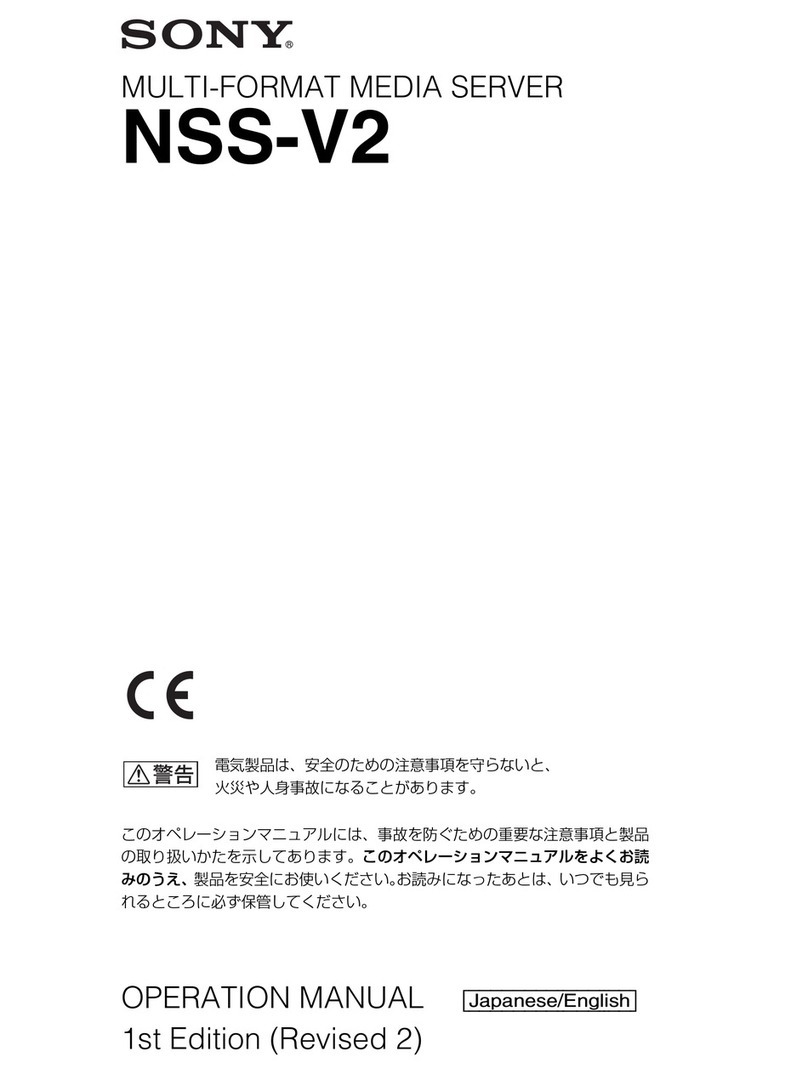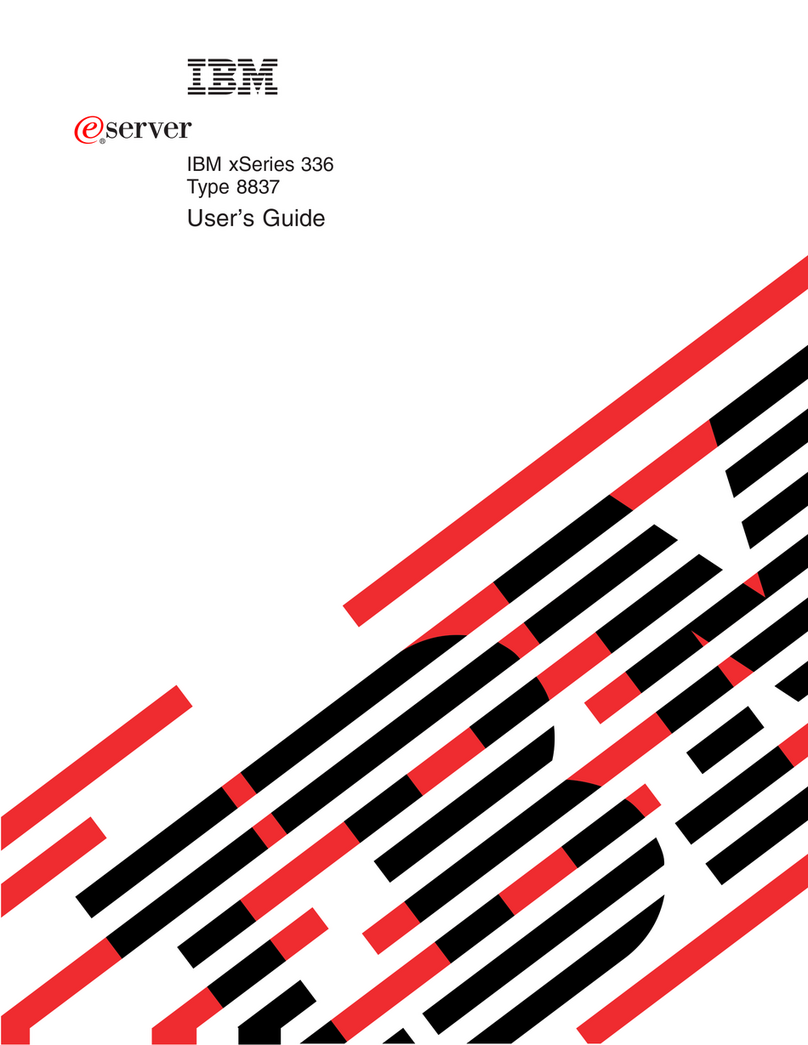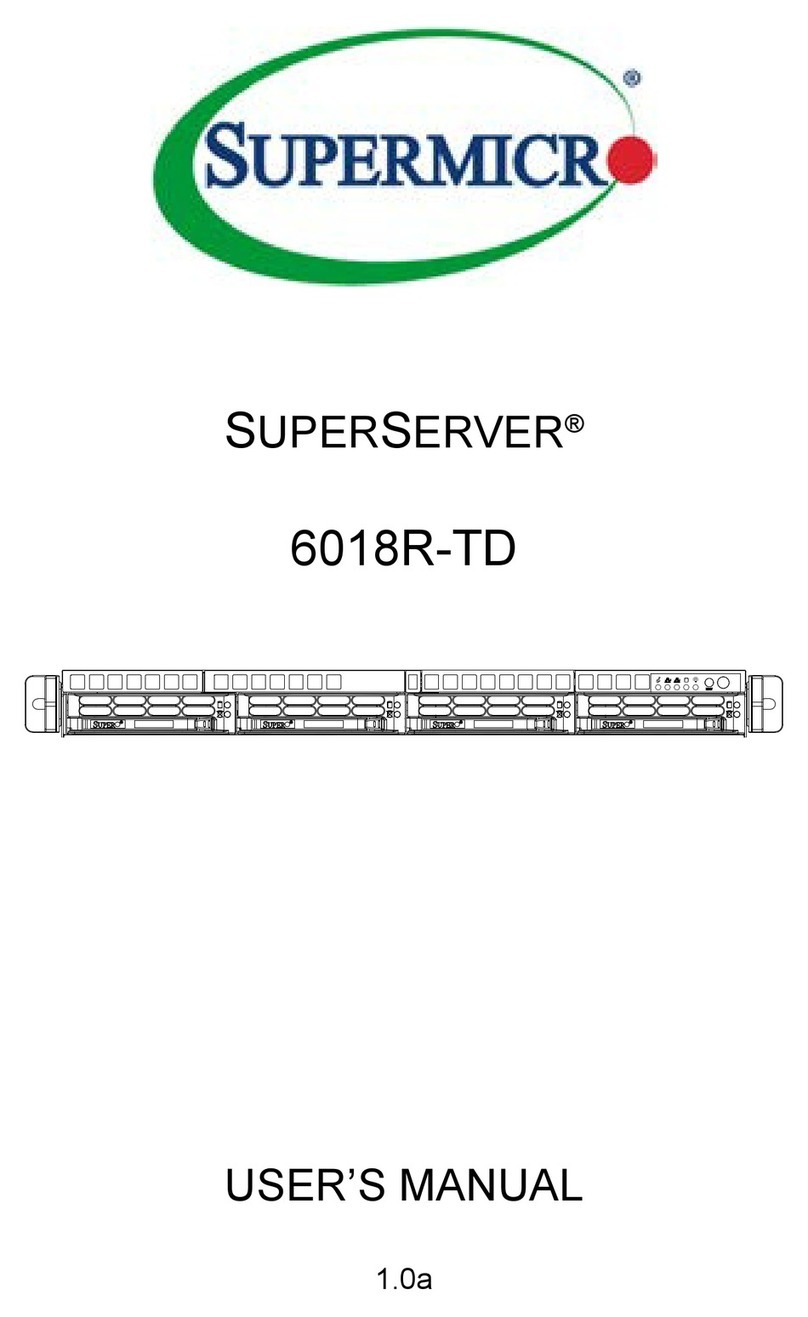ESI ESI-1000 Owner's manual

ESI Communications Servers
ESI-1000 • ESI-600 • ESI-200 • ESI-100 • ESI-50
Programming Manual
0450-1050
Rev. H
Copyright © 2009 ESI (Estech Systems, Inc.).
IVX is a registered trademark of Estech Systems, Inc. Ethernet is a registered trademark of
Xerox Corporation. Motorola and ColdFire are registered trademarks of Motorola, Inc. Rayovac is a
registered trademark of Rayovac Corporation. Act! is a registered trademark of Symantec
Corporation. Goldmine is a trademark of Goldmine Software Corporation. Microsoft, Windows, NT
and Outlook are registered trademarks of Microsoft Corporation. Panasonic and DBS are registered
trademarks of Matsushita Electric Corporation of America. Novell and Netware are registered
trademarks of Novell, Inc. Smart Jack is a trademark of Westell Technologies, Inc. Information
contained herein is subject to change without notice. Certain features described herein may not be
available at initial release. ESI products are protected by various U.S. Patents, granted and pending.
Visit ESI on the Web at www.esi-estech.com.

Contents
General description ..............................................................A.1
Flexible numbering.................................................................A.4
System capacities .................................................................B.1
Remote maintenance with ESI System Programmer...C.1
System programming: An introduction...........................D.1
Function 1: System parameters.........................................E.1
Function 11: Initialize.............................................................E.1
Functions 12 and 13: Installer and Administrator passwords..... E.1
Function 14: System clock.....................................................E.1
Function 15: System timing parameters................................. E.3
Function 16: System feature parameters...............................E.4
Function 17: System speed-dial...........................................E.12
Function 18: Maintenance/SMDR serial port........................E.13
Function 2: CO lines.............................................................F.1
Function 21: CO line programming.........................................F.1
Function 22: Translation table programming.........................F.21
Function 23: CO line parameters..........................................F.31
Function 24: Caller ID...........................................................F.33
Function 3: Extension programming............................... G.1
Function 30: Station move.....................................................G.1
Function 31: Extension definition and routing.........................G.2
Function 32: Extension feature authorization.......................G.19
Function 33: Department programming................................G.23
Function 34: Dial plan assignment.......................................G.30
Function 35: Extension button mapping...............................G.36
Function 37: ESI device programming.................................G.40
Function 4: Auto attendant programming.......................H.1
Function 41:Auto attendant branch programming.................H.1
Function 42: Announce extension number.............................H.6
Function 43:Automatic day/night mode table.........................H.7
Function 5: Voice mail programming................................I.1
Function 51: Maximum message/recording length..................I.1
Function 52: Message purge control....................................... I.1
Function 53: Guest/info mailboxes .......................................... I.2
Function 54: Group mailboxes and the broadcast mailbox......I.3
Function 55: Message notification...........................................I.3
Function 56: Cascade notification mailboxes...........................I.5
Function 57: Q & A mailboxes.................................................I.6
Function 58: Message move and delete.................................. I.6
Function 6: Recording..........................................................J.1
Function 61: Re-record system and branch prompts.............. J.1
Function 62: Record directory names..................................... J.2
Function 63: Message-on-hold (MOH) programming..............J.3
Function 7: Reports..............................................................K.1
Report printing........................................................................K.1
Reporting functions ................................................................K.1
Feature description: SMDR.................................................L.1
Standard tabular SMDR format..............................................L.1
CSV SMDR format.................................................................L.2
SMDR format when using account codes...............................L.3
Reporting conventions and rules (standard and CSV formats)L.4
Extended SMDR format.........................................................L.5
Function 8: IP programming..............................................M.1
Function 81: Display licenses................................................M.1
Function 82: Local IP programming....................................... M.2
Function 83: Esi-Link programming.......................................M.9
Function 84: SIP card programming.....................................M.11
Function 85:Application Services Card programming.........M.13
Function 86: Mobile Messaging selection............................M.13
Index
Important: For information concerning the hardware installation for an ESI Communications Server (the ESI-1000,
ESI-600, ESI-200, ESI-100, or ESI-50), see the ESI Communications Servers Hardware Installation Manual
(ESI document #0450-1049).

ESI Communications Servers Programming Manual General description
A.1
General description
ESI Communications Servers — the ESI-1000, ESI-600, ESI-200, ESI-100, and ESI-50 — are versatile,
scalable telecommunications systems for sophisticated enterprise applications. Each represents the latest
generation of ESI’s advanced communications systems, and provides much more than standard phone service.
Standard features include voice mail, automated attendant, automated call distribution (ACD), external paging
interface,and extensive call coverage features (such as off-premises “reach-me”). Optional features include
computer/telephony integration and advanced voice over IP (VoIP) communications, allowing your customers to
transition smoothly from traditional circuit-switched telephony to cost-efficient IP network-based telephony.
You or an Administrator can program the system locally or remotely, through either a phone orESI’s Windows®-
based ESI System Programmer application. Each application runs on a Windows®-compatible computer which is
connected to the system locally via serial port, remotely via the system’s built-in modem, or over Ethernet®via
the system’s built-in Network Services Processor (NSP).
Notes: Throughout this document, except where noted, we refer to each ESI port card by its functional
descriptor (usually a number), WITHOUT any “E2” or “CS” modifiers. An “E2” card and a “CS” card with the
same functional descriptor — e.g., an E2-684 and a CS-684 — are functionally identical. The difference is
that the ESI-100 accepts only “E2” port cards, while other ESI Communications Servers accepts both “E2”
and “CS” port cards.1The ESI-50 accepts only its own specific cards.
Except where noted, the remainder of this “General description” chapter describes only features, rather than
any system capacities. For system-specific capacity specifications — e.g., CO lines, ports, message
storage, etc. — see “System capacities” (page B.1).
Telephone system features
• Impressive expansion capability — Each system accepts one or more Expansion Cabinets to maximize its
potential call-handling.
• T1 and PRI support — Can connect to higher-bandwidth lines, which more and more offices use.2
• ESI Feature Phones — Compact and stylish, yet rugged, each ESI Feature Phone includes a high-quality
speakerphone, large and informative multi-functionaldisplay and a specially designed key layout with several
dedicated keys to minimize or eliminate the need to memorize codes. ESI’s 48-Key Feature Phone —
available with either full-duplex3or simplex speakerphone functionality — comes in digital and IP versions.
Each 48-Key Feature Phone model includes an integrated headset jack and is available with backlit display.
OtherESI phone models include the 24-Key Feature Phone (available with backlit display), 12-Key Feature
Phone, and Cordless Handsets (including the Cordless Handset II).4
Note: The 12-Key Feature Phone has the same stylish, rugged ESI Feature Phone design and offers the most
basic phone functions. It is intended for use in areas such as lobbies, cashier stations, warehouses and
employee lunchrooms, where only minimal phone system features are needed.
• Extensive help — ESI’s Verbal User Guide™uses spoken and displayed help prompts to help everyone from the
Installer through the Administrator down to the least experienced end user. Easily accessible with one press
of either the HELP key on the 48-Key Feature Phone or the PROG/HELP combo key on the 24-Key Feature
Phone. One can also visit www.esiusers.com for comprehensive help.
• Enhanced Caller ID — Allows one-touch automatic message return.5An ESI Communications Server
passes Caller ID data to both digital and analog ports.
• Live call recording — Can record any conversation or personal memo, with moving or copying of any
recording to another user’s voice mailbox (see “Voice mail features,” below).
• Call waiting — Includes helpful display, showing both calls’ Caller ID information, and easy one-key toggling
between calls.
1In the ESI-1000, ESI-600, and ESI-200, use of an “E2” port card also requires a“Hot Swap” Port Card Adapter (ESI part #5000-0385).
2The ESI-50 supports only PRI (not T1).
3Full-duplex speakerphonesupported only by system softwareversionsxx.xx.xx (and higher).
4See also the ESI Communications Servers Hardware Installation Manual(ESI document #0450-1049).
5This and all other references to Caller ID service within this manual assume the end-user organizationsubscribes to Caller ID service from its
telephone service provider.

ESI Communications Servers Programming Manual General description
A.2
• Conference calling — Includes up to 64 dynamic conference ports; a single conference may contain up to
16 members.1Conference bridges are dynamic, so possible conference sizes include:21 three-member; 16
four-member; 10 six-party; and various combinations in-between.Analog phones on the system also may
originate conferences.
• Esi-Dex™speed-dialing — Calls any number using four separate lists (personal,station, system and —
when Esi-Link is in use — cabinet location);uses Caller ID information ordirect keypad entries.
• Dedicated overhead paging interface —Allows for external paging through overhead speakers or multi-
zone paging units (amplification required) and separate, vendor-supplied zone page adapters.
• Intelligent Call Forwarding™— Lets users of compatible PRI-equipped ESI systems view the original Caller ID
data of a call forwarded to an off-premises phone.
• 911 alert — Provides immediate line access if any station2dials 9 1 1 to report an emergency; sends a
message via the serial port indicating the start date, time, station number and end-time of the 911; also
sounds an audible warning at the operator station and displays, for example:
911 CALL FROM
X102 JOHN JAMES
Important: Remember to advise your customers not to make 911 calls using a remote IP phone.3Because such a
phone isn't connected directly to the local telephone network, it’s necessary instead to use a regular
phone connected locally, not the remote IP phone, to make 911 or other emergency calls. (For more
information, see the documentation included with the remote IP phone.)
• Shared-office tenanting — Tenant service allows multiple business entities to share a telephone system while
maintaining separation of various facilities and features. For more details, see “Shared-office tenanting,” page A.4.
• Support for these options:
–Esi-Link — Allows a multi-site enterprise to network any combination of dozens of compatible ESI systems
across an IP-based network. For details, see the Esi-Link Product Overview (ESI document # 0450-0214).
Notes: The ESI-50 uses only the G.726 speech compression algorithm and, therefore, can be in an Esi-Link
network with only other ESI Communications Servers set to G.726 (in Function 835; for details, see
page M.11).
ESI’s IVX®X-Class and IVX E-Class systems, as well as the original ESI-600 (prior to system
software version 16.2.0), use only the G.729 speech compression algorithm; thus, an ESI-50 cannot
be in an Esi-Link network with these systems.
–Unified communications
• VIP™— Provides a value-added interface to all ESI Communications Servers. Delivers call control and
unified messaging toMicrosoft®Outlook®2000/2002/2003/2007. For details,see the VIP Product Overview
(ESI document # 0450-0608) and VIP ACD Product Overview (ESI document # 0450-0988).
• ESI Mobile Messaging4— Delivers unified messaging to any e-mail client. Allows receiving voice mail
messages as e-mail attachments. Can be used withVIP for even better voice mail management.
–ESI Presence Management — Provides integrated building entry control, access control, status
indication, personal call routing, and (optionally) time and attendance management.For details, see
the ESI Presence Management Product Overview (ESI document # 0450-0794).
–ESI Cellular Management — Partof ESI Bluetooth Voice Integration, ESI Cellular Management provides
unique hardware and features to bridge the gap between cellular handsets and ESI’s line of Feature Phones.
For details, see the ESI Bluetooth Voice Integration Product Overview (ESI document # 0450-1173).
–SIP trunking5— Used with an Internet telephony service provider, allows connection to the PSTN via the
Internet using the SIP (Session Initiation Protocol) VoIP standard.
1See “System capacities” (page B.1).
2An ESI Remote IP Cordless Handset (II or original)sends 911 calls via the local analog CO line attached to the Cordless Handset’s base station.
The 911 alert information isn’t available at the operator station or viaserial port.
3A remotely installed IP Feature Phone II, aRemote IP Cordless Handset, or a remote installationof VIP Softphone.
4Requires ESI Communications Server with specific hardware and software. See the ESI Mobile Messaging Installation Guide (ESI # 0450-1231).
5Requires ESI Communications Server with specific hardware and software. See theESI SIP Trunking Installation Guide (ESI # 0450-1227).

ESI Communications Servers Programming Manual General description
A.3
Voice mail features
• Built-in voice mail ports — These are in addition to the call-processing ports; thus, you may build the
system to its maximum for call-handling without having to balance voice mail needs versus call-handling needs.
For specific voice storage capacities on a system-by-system basis, see “System capacities” (page B.1).
• Highest-grade voice quality (64-kilobit/second sampling) for voice mail and other storage of voice messages.
• Message-on-hold (MOH) recordings —Among these are threeprerecorded tracks;also supports live entry. With
tenant service enabled (see “Tenant service features,” pageA.4), each tenant has its own MOH source.
• Off-premises message delivery — Automatically delivers voice messages to designated phone number,
such as a cell phone, when one is out of the office.
• Urgent messages — Can deliver higher-priority messages first.
• Several different mailbox types, including group, broadcast, informational, cascade notification and Q & A.
• Message Recycle Bin (undelete) — Remembers, and can restore, each mailbox’s 10 most recently
deleted messages.
• Quick Groups™— Makes it easy to leave voice mail messages for several users.
• Quick Move™— Records a conversation into another user’s mailbox.
• Virtual Mailbox Key™allows easy monitoring of a second mailbox.
• Optional ESI Mobile Messaging delivers voice mailas a .WAV file to your smartphone or the inbox of
nearly any e-mail client application.
Auto attendant features
• Six levels, 100 branches — Allow you and your customer to set up a more caller-friendly answering
environment, including a company directory.
• Virtually unlimited call routing — Includes off-premises transfer, pager notification, more.
ACD features
• Routes calls within designated departments for quickest possible call answering.
• Uses three-line Digital Feature Phone display to provide up-to-the-second information on queues,
wait times, delay announcement, priority queueing, and overflow routing.
• Optional VIP ACD Supervisor and VIP ACD Agent enhance ACD usage; VIP ACD Supervisor offers highly
useful reports and also gives ability to customize reports.1
(Continued)
1Report customization requires either Crystal Reports Standard Edition or Crystal Reports Professional Edition (not available from ESI).

ESI Communications Servers Programming Manual General description
A.4
Shared-office tenanting
• Can be configured to support up to eight tenants.1
• CO lines — CO line groups and corresponding access codes can be used to separate each tenant’s CO linesif
required. “Pooled” or shared lines can be assigned to a line group to which all stations are allowed access.
CO lines are assigned to tenants for the purpose of following each tenant’s day/night mode.
• Stations and departments — Each station and department can be assigned to one tenant.
• Automatic day/night mode — If this is enabled, each tenant will follow day/night mode changes assigned in
its unique table.
• Day/night key — A day/night key may be assigned to select day or night mode manually for each tenant.
• Auto attendant day/night greeting — Each tenant may use a dedicated day/night branch ID2to route to a
destination. Day/night routing will be controlled either automatically by each individual tenant’s day/night
tables or manually by use of a day/night key for each tenant.
• Message-on-hold (MOH) — Each tenant will have a unique customer-recorded MOH source.
• Central answering — Central answering makes it possible for one extension (or department) to answer
incoming calls to different tenants.
• Operator (dial-“0”) routing — Unique operator call routing may be assigned to each tenant.
• Hold — Foreach tenant, a specific MOH can be assigned, based on CO line.
Flexible numbering
Flexible numbering provides the means to assign extension, voice mailbox, and department numbers based on
specific customer requirements. ESI’s flexible numbering is separated into three parts:
1. Selection ofa starting numbering plan template.
2. Reassignment of ranges of extensions and (if needed) guest mailboxes.
3. Reassignment of individual extensions and (if needed) guest mailboxes and department numbers.
Selectable numbering plans (Function 169)
The selectable numbering plan template is the basis for flexible numbering assignment. When a
numbering template is selected, all extensions, mailboxes, departments, and other system features are
automatically assigned with the numbering plan of that template. Choosing the template that is closest to the
customer’s existing configuration greatly simplifies, or even eliminates the need for, number reassignment.
(See “Selectable numbering plan,” page D.2.)
Note: Full system capacity can be achieved only through use of a four-digit selectable numbering plan (see
page D.2).
(Continued)
1See “System capacities” (page B.1).
2See“Function 41: Auto attendant branch programming,” pp.H.1–H.6.

ESI Communications Servers Programming Manual General description
A.5
Range reassignment (Function 34 extended; ESI System Programmer only)
Included in ESI System Programmer, flexible number range assignment is used to change the numbers of
a block, or range, of extensions or guest mailboxes.1Range reassignmentcan be used either at time of
installation or after the system is installed.
Number reassignment (Function 34)
Number reassignment lets you assign new (or reassign existing) individual extensions2, departments, and
guestmailbox numbers — all throughout the entire Esi-Link network.
Station move (Function 30)
Station move is used by the Installer or SystemAdministrator to move, or exchange, extension numbers and
other station information between extensions of the same station type.3Programmable feature keys, personal
greetings, voice mail messages,and other system information are automatically and instantly exchanged
between the two stations when this is done.
Esi-Link and flexible numbering: Limitations
The following table lists the Esi-Link compatibility of various ESI products with an ESI Communications Server
using flexible numbering.
REMOTE site’s ESI system REMOTE site’s
system software version LOCAL system’s
numbering plan template Resulting Esi-Link
compatibility
ESI-1000, -200, -100, or -50 [All] Any Complete
Feature Set II (16.1.0 or higher) Any Complete
ESI-600 Feature Set I (15.2.x or lower) Any Limited
Any three-digit Limited
10.6.0 or higher Any four-digit None
Dial plan template 100 Limited
IVX X-Class 10.5.x or lower Any other dial plan None
Any three-digit Limited
2.5.2 or higher Any four-digit None
Dial plan template 100 Limited
IVX E-Class Generation II 2.5.1 or lower Any other dial plan None
In this chart, limited compatibility means that, when you use Function 34 (number reassignment), you must
keep the extension and mailbox ranges within their original numbering plan template ranges.
Example: Let’s say your local system is an ESI-600 using numbering plan 100. If you swap extension 100 with
mailbox 300 — i.e., so that station 100 is now extension 300, and mailbox 300 is now mailbox 100 — an
IVX X-Class system that dials station 300 over Esi-Link won’t be able to process the call correctly,
because that station is no longer within the numbering template. However, if you merely swap
extensions 100 and 120 on that same ESI-600, an Esi-Linked IVX X-Class will be able to process a call
to extension 120 (because the changed extension is still within the numbering template).
For proper operation, two or more Esi-Linked ESI Communications Servers of thesame modelshould all be
running the same system software version. However, an ESI system without flexible numbering-compatible
system software will still be compatible with an ESI Communications Server with flexible numbering-
compatible system software;yet, the ESI Communications Server with flexible numbering will remain subject
to the same Function 34-related limitations described above.
1Range assignment of department numbers and special-purpose mailboxes is not supported at initial release of this system software. However,
Function 34 can be used to reassign department numbers.
2Valid extensions also can be swapped throughout the Esi-Link network.
3Such stations must be like types — e.g., Digital Feature Phone to Digital Feature Phone, IP Feature Phone to IP Feature Phone, or analog
extension to analog extension.

ESI Communications Servers Programming Manual System capacities
B.1
System capacities
Important: Each ESI Presence Management RFID Reader uses one digital station. The same is true for each ESI
Cellular Management Access Device.
Stations and trunks
The specifications shown below reflect maximum capacities and configurations.Not all of the station and trunk
maximums can be reached simultaneously.
Example: The ESI-100 can’t achieve 72 IP stations and 48 digital stations and 28 analog stations and 42 trunks
and 24 Esi-Link stations at the same time, because the system’s four-port-card limit makes such a
configuration impossible. The maximum configuration for this system is 108 ports, which could be achieved
by one DLC12 card (24 T1 trunks, 12 digital stations), two IVC 24Rs (48 IP stations), and one IVC EL24
(24 Esi-Link channels).
ESI-1000 ESI-600 ESI-200 ESI-100 ESI-50
Dialing plans (-digits)
Four Three Four Three Four Three Four Three Four Three
Max. port cards 42 14 28 14 14 14 4 4 414
1
Max. port configuration21,128 276 624 276 300 276 108 108 87 87
– Max. stations 816 168 408 168 192 168 84 84 52 52
– Max. IP stations 816 168 408 168 192 168 72 72 12 12
– Max. digital stations 504 168 336 168 168 168 48 48 32 32
– Max. analog stations 384 56 188 56 56 56 28 28 8 8
Max. CO lines 240 84 168 84 84 84 42 42 35 35
Max. DLCs (T1/PRI) 6 3 6 3 3 3 1 1 131
3
Max. IVCs 34 7 17 7 8 7 3 3 141
4
Max. Esi-Link port cards (up to 24
Esi-Link channels5per card) 4 4 2 2 1 1 1 1 1 1
Max. SIP Cards 10 3 6 3 3 3 1 1 1 1
Total number of SIP trunks 240 72 144 72 72 72 24 24 24 24
Maximum lines available 240 84 168 84 84 84 42 42 35 35
Dedicated ports
ESI-1000 ESI-600 ESI-200 ESI-100 ESI-50
Dialing plans (-digits)
Four Three Four Three Four Three Four Three Four Three
Voice mail/auto attendant ports6128 128 32 32 16 or 24
16 or 24
8 8 8 8
Conference ports (max. of 16
members per conference) 64 64 64 64 24 24 16 16 16 16
NSP71 1 1 1 1 1 1 1 1 1
Overhead paging ports81 1 1 1 1 1 1 1 1 1
Serial/SMDR ports 1 1 1 1 1 1 1 1 1 1
Voice mail capacities
ESI-1000 ESI-600 ESI-200 ESI-100 ESI-50
Dialing plans (-digits)
Four Three Four Three Four Three Four Three Four Three
Voice mail storage (hours) 1,200 1,200 1,200 1,200 140 or
600 140 or
600 140 140 15 or 60
15 or 60
Broadcast mailbox (one to
all extensions) Yes Yes Yes Yes Yes Yes Yes Yes Yes Yes
Cascade notification mailboxes 40 10 20 10 10 10 10 10 10 10
Group mailboxes/max. members 64/200 32/200 32/64 32/64 16/64 16/64 16/32 16/32 16/32 16/32
Guest/info mailboxes 1,000 190 1,000 190 1,000 190 1,000 190 190 190
Maximum station mailboxes 816 168 408 168 192 168 84 84 52 52
Q & A mailboxes 20 10 20 10 10 10 10 10 10 10
1Includes built-in 482 port card.
2Includes Esi-Link channels.
3ESI-50 supports only PRI.
4IVC 12 is built into ESI-50 main board.
5Esi-Link channels are allocated to “reserved” ports; i.e. Esi-Link channels do not reduce CO or station capacity.
6On the ESI-200: 16 ports for 140-hr. model, 24 ports for 280-hr. and 600-hr. models.
7Network Services Processor; see the ESI Communications Server Hardware Installation Manual(ESI # 0450-1049).
8On the ESI-200: A non-IVC card must be installed inslot 1 or 2.On the ESI-100: An IVC can’t be installed in slot 1.

ESI Communications Servers Programming Manual System capacities
B.2
Departments
ESI-1000 ESI-600 ESI-200 ESI-100 ESI-50
Dialing plans (-digits)
Four Three Four Three Four Three Four Three Four Three
Max. departments 128 20 64 20 20 20 10 10 10 10
Department types: Ring-all,ACD,
UCD, in-order, pick-up, attendant Yes Yes Yes Yes Yes Yes Yes Yes Yes Yes
Max. members, non-ring-all depts.
64 64 64 64 48 48 32 32 32 32
Max members, ring-all depts. 48 48 48 48 48 48 32 32 32 32
Shared-office tenanting
ESI-1000 ESI-600 ESI-200 ESI-100 ESI-50
Dialing plans (-digits)
Four Three Four Three Four Three Four Three Four Three
Tenants 8 8 8 8 4 4 2 2 2 2
CO line groups
ESI-1000 ESI-600 ESI-200 ESI-100 ESI-50
Dialing plans (-digits)
Four Three Four Three Four Three Four Three Four Three
Line groups 9, 8, 71–76 Yes Yes Yes Yes Yes Yes Yes Yes Yes Yes
Max. members, CO ring
assignment list 48 48 48 48 48 48 32 32 32 32
Translation tables
ESI-1000 ESI-600 ESI-200 ESI-100 ESI-50
Dialing plans (-digits)
Four Three Four Three Four Three Four Three Four Three
Pilot numbers (non-SIP)180 80 40 40 20 20 10 10 10 10
Pilot numbers (using SIP)2100 100 100 100 100 100 100 100 100 100
Max. DID entries (non-SIP) 1,200 1,200 600 600 300 300 300 300 300 300
System speed-dial numbers
ESI-1000 ESI-600 ESI-200 ESI-100 ESI-50
Dialing plans (-digits)
Four Three Four Three Four Three Four Three Four Three
System speed-dial numbers 1,000 100 1,000 100 1,000 100 1,000 100 100 100
Maximum installations of VIP applications
ESI-1000 ESI-600 ESI-200 ESI-100 ESI-50
Dialing plans (-digits)
Four Three Four Three Four Three Four Three Four Three
Installations,
VIP PC Attendant Console 16 16 8 8 4 4 2 2 2 2
Installations,
VIP auto-recording 32 32 16 16 8 8 4 4 4 4
Installations,
VIPACD Supervisor 16 16 8 8 4 4 2 2 2 2
ESI Mobile Messaging features
ESI-1000 ESI-600 ESI-200 ESI-100 ESI-50
Dialing plans (-digits)
Four Three Four Three Four Three Four Three Four Three
Maximum stations2816 816 408 408 168 168 84 84 52 52
Maximum guest mailboxes2250 250 250 250 100 100 50 50 50 50
1Prior to June 15, 2009.
2With the release on or after June 15, 2009.

ESI Communications Servers Programming Manual System capacities
B.3
ESI Presence Management features
ESI-1000 ESI-600 ESI-200 ESI-100 ESI-50
Dialing plans (-digits)
Four Three Four Three Four Three Four Three Four Three
RFID Reader access door records
50,000 50,000 10,000 10,000 10,000 10,000 10,000 10,000 10,000 10,000
RFID Reader entries in Fn. 372164 64 32 32 32 32 16 16 16 16
Max. RFID tags (“electronic keys”)
2,000 2,000 500 500 500 500 500 500 500 500
ESI Cellular Management features
ESI-1000 ESI-600 ESI-200 ESI-100 ESI-50
Dialing plans (-digits)
Four Three Four Three Four Three Four Three Four Three
Support for ESI Cellular Mgmt. Yes Yes Yes Yes Yes Yes Yes Yes Yes Yes
1See the ESI Presence Management Installation Manual (ESI document #0450-0792).

ESI Communications Servers Programming Manual Remote maintenance with ESI System Programmer
C.1
Remote maintenance with ESI System Programmer
ESI System Programmer gives the Installer the capability to program all phone system features, including
IP addresses for Remote Phones and Esi-Link. ESI System Programmer can be used from a PC or laptop
connected directly to the system on-site; it can also connect to the system remotely via TCP/IP or dialup.
ESI System Programmer can be used remotely by the Installer to make adjustments to a site’s ESI
Communications Server. This section will cover how to use ESI System Programmer in conjunction with the
system’s Network Services Processor (NSP) for remote maintenance.
Required equipment and information:
• A programmed and connected NSP must be in the site’s ESI Communications Server.
(The NSP itself is standard.)
• You will also need to know the site’s NSP IP address.
• The PC or laptop must have an Ethernet interface and have a broadband connection to the LAN, WAN,or
Internet (depending upon the type of remote connection involved).
• TCP/IP port number 59002 for the site’s router.
ESI System Programmer setup
WARNING: Do NOT back-load ESI System Programmer to a version prior to 1.1.12.0. Doing so will cause ESI
System Programmer to fail to launch, and could damage site files.
1. Contact the site to port-forward TCP/IP port 59002 from the router to the NSP’s IP address. Verify that the
port prefix of 59 hasn’t changed (if it changed to 56, forexample, the port number would be 56002 rather
than 59002). If the customers are unaware how to port-forward, have them refer to the router’sUser’s Guide.
Important: For an explanation of how the port forwarding works, see “Configuring the remote office NAT router”
in the NSP/VIP Advanced Options Guide (ESI part #0450-0667).
2. After port forwarding is complete, install ESI System Programmer on your PC. ESI System Programmer
can be found on the software page of the Resellers’ Web site:www.esiresellers.com/software.
3. Follow directions in the ESI System Programmer User’s Guide (# 0450-1046) for setting up a site.
Connecting to the site
Important: ESI strongly recommends connecting to the ESI
Communications Server via the NSP, for a faster
and more stable connection.
Once the site is created and the network settings are entered,
connect to the site using network communications:
1. Highlight the site and right-click. In the resulting
drop-down menu, click Connect, then Network/NSP.
2. Once the dialog box shows you’re connected,
click Close and then begin programming
Once you are connected to the site, you can program
features as if you were actually there.

ESI Communications Servers Programming Manual Remote maintenance with ESI System Programmer
C.2
Interface Version field
The General tab in ESI System Programmer 1.2.0.0 (or later)
includes an Interface Version (I.V.) field.
This field provides four values — 0, 1, 2, and 3:
• Zero is synonymous with ESI Communications Server
system software versions released prior to
April 25, 2008.
• One is synonymous with ESI Communications Server
system software versions released after
April 25, 2008 and before April 24, 2009.
• Two is synonymous with ESI Communications Server
system software versions released on or after
April 24, 2009 and before June 15, 2009.
• Three is synonymous with ESI Communications Server
system software versions released on or after
June 15, 2009.
When you load ESI System Programmer 1.2.0.0 (or later), any
sites you created with an earlier version ofESI System
Programmer will automatically be set to an I.V. of 0.
When you create a new site for an ESI-100, ESI-200,
ESI-600, or ESI-1000, you’ll have the choice to set the I.V. to 0, 1, or 2. Set the I.V. to the appropriate version
for the system software you’re using, based on the dates listed above.(When you create a new site for an
ESI-50, however, the I.V. will automatically be set to 1.)
Once the site properties are entered and you choose Apply or OK, the I.V. for that site can’t be changed (as
is true for the system numbering plan; see “Selectablenumbering plan,” page D.2).

ESI Communications Servers Programming Manual System programming: An introduction
D.1
System programming: An introduction
You can program an ESI Communications Server either(a.) from a 24-Key or 48-Key Feature Phone1in the
system or (b.) with the Windows®-based ESI System Programmer package. Both methods follow the same
programming steps. This manual focuses on programming from a Feature Phone; the respective documentation
for ESI System Programmer details the differences in programming from that environment.
Read the User’s Guide first. Programming features require a clear understanding ofuser interface
and application.
Once you’ve accessed programming mode on a 24-Key or 48-Key Digital Feature Phone, the system will prompt
for — and confirm — each keystroke action via voice commands and the display. You program both
configuration data and recordings in the same manner.
Important: During programming, the 24-Key Feature Phone’s two-line display shares the same content as the top two
lines of the 48-Key Feature Phone’s three-line display. As a result, to save space, the sample displays
shown herein will show only two lines.
If installing ESI Presence Management on this system, refer to the ESI Presence Management Installation
Manual (ESI # 0450-0792) for important information before you program the system.
Programming keys
During programming, the first line of the display will show the currentitem being programmed, and the second line
will be the entry line. You can enter values as directed by the combination of the voice prompts and display.
To enter multiple values, such as a list of extension numbers, separate each value by #(to exit the list, enter # #).
To... Press ... What this does
Enter # Confirms new or existing entry and advances to next
programming step.
Back up (i.e., reverse direction)
Backs up to previous prompt without changing its value.
Delete HOLD Deletes data or recording.
Exit [Hang up] Exits programming mode and removes extension from DND.
Help HELP Provides more detailed instructions during programming.
(left-side scroll key) • During entry of a value, backs up.
• If a list is present (“>” is displayed), scrolls to left.
Select/scroll
(right-side scroll key) • Selects from options presented.
• If a list is present (“>” is displayed), scrolls to right.
• Inserts a space during entry of a name.
Notes: Either <or >in the display indicates that additional choices or values are available by pressing a
corresponding scroll key (
or
).
Only one person at a time can be performing Installer orAdministrator programming.
1ESI doesn’t recommend programming the system using a12-Key Feature Phone, andyoucannot doso using an ESI Cordless Handset.

ESI Communications Servers Programming Manual System programming: An introduction
D.2
Entering alphanumeric characters
You enter names for extensions, departments, branch IDs, CO lines, guest mailboxes and DIDs by
pressing the dial pad key that corresponds to the character to be entered. The key’s possible entries will change
each time the key is pressed, and the display will show this. When the desired character appears on the display,
press #to confirm; the cursor will move to the next character position. You may move the cursor left (to correct
an entry) by pressing the left scroll key (
) or move right (to add a space) by pressing the right scroll key (
).
Key Options Key Options
0 0, - (hyphen), _ (underline) 7 P, R, S, p, r, s, 7
1 Q, Z, q, z, 1, “_” (space) 8 T, U, V, t, u, v, 8
2 A, B, C, a, b, c, 2 9 W, X, Y, w, x, y, 9
3 D, E, F, d, e, f, 3
(left scroll key) Backs up and erases
4 G, H, I, g, h, i, 4
(right scroll key) Adds a space
5 J, K, L, j, k, l, 5 # [Enter]
6 M, N, O, m, n, o, 6 # # Ends the name
Important: Lower-case letters are available only for programming Function 84 settings (page M.11).
Example: To enter aB, press 2twice (the possible options to scroll through are A, B, C, a, b, c, and 2). WhenBappears,
press #to confirm; the cursor will move to the next character to be entered. To complete the name, press # #.
Note: On an incoming call, the name you assigned to the call’s CO line or DID — rather than the Caller ID data —
will appear until the call is answered.
Selectable numbering plan
The ESICommunications Server’s selectable numbering plan offers up to nine pre-configured ranges —
three three-digit plans and six four-digit plans. When an extension range is selected, department numbers and
guestmailbox numbers are also changed. However, regardless of which extension range is selected, feature key
codes, and CO line group access numbers will stay the same. The dial plan range is selected through Installer
programming Function 169 (see page E.10 for more information).
Notes: The ESI Presence Management RFID Reader1uses one digital extension, regardless of dial plan.
The IP Feature Phone II, the IP Cordless Handset (Local or Remote),VIP Softphone, and a SIP phone
each use one IP port, regardless of dial plan.
Important: Full capacity on the ESI-1000, ESI-600, or ESI-200 can be achieved only by using a four-digit plan.
(See “System capacities,” page B.1.)
1For more information, see the ESI Presence Management Installation Manual(ESI # 0450-0792).

ESI Communications Servers Programming Manual System programming: An introduction
D.3
Three-digit numbering plan selections (all ESI Communications Servers)
Selection 100 (default) Selection 200 Selection 300
From
To
Used for From
To
Used for From
To
Used for
100
267
Extensions 200
367
Extensions 300
467
Extensions
280
299
Departments 380
399
Departments 470
489
Departments
300
489
Guest/info mboxes 100
199
Guest/info mboxes 100
289
Guest/info mboxes
400
489
Guest/info mboxes
Common to all three-digit numbering plan selections (all models)
From
To
Used for From
To
Used for
0
—
Operator 700
709
Esi-Link1locations
490
499
Q & A mailboxes 770
799
Esi-Link locations
500
—
Broadcast mailbox 71
76
Esi-Link/CO line grps.
501
532
Group mboxes 8
—
CO line grp.
533
542
Cascade notif. mboxes 9
—
CO line grp./ARS
600
699
System speed-dial
—
Call pickup
#
—
Paging
Four-digit numbering plan selections (ESI-600, ESI-200, ESI-100, and ESI-50)
Note: The “From” number is the same on all systems. The “To” number is dependent on the system type
because of the specific capacities of each system. See “System capacities” (page B.1).
Selection 1000 Selection 2000 Selection 3000
From
To
Used for From
To
Used for From
To
Used for
1000
1407
Extensions 2000
2407
Extensions 3000
3407
Extensions
1408
1471
Departments 2408
2471
Departments 3408
3471
Departments
3000
3999
Guest/info mboxes 3000
3999
Guest/info mboxes 2000
2999
Guest/info mboxes
4000
—
Broadcast mailbox 4000
—
Broadcast mailbox 4000
—
Broadcast mailbox
4001
4032
Group mboxes 4001
4032
Group mboxes 4001
4032
Group mboxes
4040
4059
Q & A mboxes 4040
4059
Q & A mboxes 4040
4059
Q & A mboxes
4060
4079
Cascade notif. mboxes 4060
4079
Cascade notif. mboxes 4060
4079
Cascade notif. mboxes
6000
6999
System speed-dial 6000
6999
System speed-dial 6000
6999
System speed-dial
Selection 4000 Selection 5000 Selection 6000
From
To
Used for From
To
Used for From
To
Used for
4000
4407
Extensions 5000
5407
Extensions 6000
6407
Extensions
4408
4471
Departments 5408
5471
Departments 6408
6471
Departments
3000
3999
Guest/info mboxes 3000
3999
Guest/info mboxes 3000
3999
Guest/info mboxes
2000
—
Broadcast mailbox 4000
—
Broadcast mailbox 4000
—
Broadcast mailbox
2001
2032
Group mboxes 4001
4032
Group mboxes 4001
4032
Group mboxes
2040
2059
Q & A mboxes 4040
4059
Q & A mboxes 4040
4059
Q & A mboxes
2060
2079
Cascade notif. mboxes 4060
4079
Cascade notif. mboxes 4060
4079
Cascade notif. mboxes
6000
6999
System speed-dial 6000
6999
System speed-dial 2000
2999
System speed-dial
Common to all four-digit numbering plan selections for these models
From
To
Used for From
To
Used for
0
—
Operator 8
—
CO line grp.
71
76
CO line grps. or
Esi-Link loc. prefixes 9
—
CO line grp./ARS
700
709
Esi-Link locations
—
Call pickup
770
799
Esi-Link locations #
—
Paging
1See “Function 8: IP PBX programming,” beginning on page M.1.

ESI Communications Servers Programming Manual System programming: An introduction
D.4
Four-digit numbering plan selections (ESI-1000 only)
Selection 1000 Selection 2000 Selection 3000
From
To
Used for From
To
Used for From
To
Used for
1000
1815
Extensions 2000
2815
Extensions 3000
3815
Extensions
1872
1999
Departments 2872
2999
Departments 3872
3999
Departments
3000
3999
Guest/info mboxes 3000
3999
Guest/info mboxes 2000
2999
Guest/info mboxes
4000
—
Broadcast mailbox 4000
—
Broadcast mailbox 4000
—
Broadcast mailbox
4001
4064
Group mboxes 4001
4064
Group mboxes 4001
4064
Group mboxes
4065
4084
Q & A mboxes 4065
4084
Q & A mboxes 4065
4084
Q & A mboxes
4085
4124
Cascade notif. mboxes 4085
4124
Cascade notif. mboxes 4085
4124
Cascade notif. mboxes
6000
6999
System speed-dial 6000
6999
System speed-dial 6000
6999
System speed-dial
Selection 4000 Selection 5000 Selection 6000
From
To
Used for From
To
Used for From
To
Used for
4000
4815
Extensions 5000
5815
Extensions 6000
6815
Extensions
4872
4999
Departments 5872
5999
Departments 6872
6999
Departments
3000
3999
Guest/info mboxes 3000
3999
Guest/info mboxes 3000
3999
Guest/info mboxes
2000
—
Broadcast mailbox 4000
—
Broadcast mailbox 4000
—
Broadcast mailbox
2001
2064
Group mboxes 4001
4064
Group mboxes 4001
4064
Group mboxes
2065
2084
Q & A mboxes 4065
4084
Q & A mboxes 4065
4084
Q & A mboxes
2085
2124
Cascade notif. mboxes 4085
4124
Cascade notif. mboxes 4085
4124
Cascade notif. mboxes
6000
6999
System speed-dial 6000
6999
System speed-dial 2000
2999
System speed-dial
Common to all four-digit numbering plan selections for the ESI-1000
From
To
Used for From
To
Used for
0
—
Operator 8
—
CO line grp.
71
76
CO line grps. or
Esi-Link loc. prefixes 9
—
CO line grp./ARS
700
709
Esi-Link locations
—
Call pickup
770
799
Esi-Link locations #
—
Paging
Line groups
The numbers 9, 8, and 71–76 are designated as line groups. A line group is, as the name implies,a specific
group of lines in a key system that are used for making outgoing calls. In an ESI Communications Server, line
groups give phones access to outside lines without taking up any programmable keys on each phone.
Note: Line groups 71–76 may conflict with Esi-Link locations 710–769 (if they’re needed); refer to Function 164
(see page E.6).

ESI Communications Servers Programming Manual System programming: An introduction
D.5
System programming overview
1 System parameters
11 Initialize
12 Installer password
13 Administrator password
14 System clock
141 Set time/date
142 Automatic time setting
143 Clock adjustment
15 System timing parameters
151 Flash duration
152 Transfer forward timer
153 Recall timers
1531 Exclusive hold
1532 System hold
1533 Hold recall rings
154 ACD timers
1541 ACD exit timer
1542 ACD wrap timer
1543 ACD hold recall timer
155 ACD wrap timer
156 Cell phone delay
157 Device timers
158 VIP Attendant exit timer
16 System feature parameters
161 Recording alert tone
162 Connect tone
163 Station featureset activation
164 Esi-Link location no./line group access selection
165 Auto attendant parameters
166 CO line parameters
167 Voice mail parameters
169 Featureset activation
17 System speed-dial
18 Maintenance/SMDR serial port
2 CO line programming
21 Line programming
211 Analog CO line programming
212 T1 programming
2121 CO line programming
2122 T1 frame format and line coding
2123 Line build-out
2124 CSU emulation
213 PRI programming
2131 CO line programming
2132 Line build-out
2133 CSU emulation
2134 Switch protocol
2135 DID
214 SIP trunk programming
2141 SIP trunk programming day/night mode
2142 SIP account programming
2145 SIP pilot table programming
22 Translation table programming
221 Centrex/PBX access code
222 Toll restriction exception tables
223 ARS (Automatic Route Selection)
224 DID and DNIS/ANI translation table
225 PRI pilot number translation table
226 Local allow table
23 Line parameters
231 Line receive volume
232 Analog line disconnect
233 T1 line receive volume
234 PRI line receive volume
24 Caller ID programming
3 Extension programming
31 Extension definition and routing
32 Extension feature authorization
321 Standard feature authorization
322 Advanced feature authorization
33 Department programming
331 Department definition and routing
332 VIP ACD parameters
34 Dial plan assignment
341 Flexible number assignment
342 Network numbering
35 Extension button mapping
37 ESI device programming
371 Access schedules
372 RFID tag programming
373 View RFID tag numbers
374 ESI Presence Management parameters
375 ESI Presence Management Reader parameters
30 Station move1
4 Auto attendant programming
41 Auto attendant branch programming
42 Announce extension number
43 Automatic day/night mode table
5 Voice mail programming
51 Maximum message/recordinglength
52 Message purge control
53 Guest/info mailboxes
54 Group mailboxes
55 Message notification options
551 Station delivery options
552 Delivery/paging parameters
56 Cascade notification mailboxes
57 Q & A mailboxes
58 Move and delete messages
6 Recording
61 Record system prompts
62 Record directory names
63 MOH programming
631 MOH source
632 Record MOH
633 MOH volume
7 Reports
71 System reports
711 Programming report
712 Diagnostic reports
72 ESI Presence Management access door report
73 ACD department detail report
74 Voice mail statistics report
75 System speed-dial list
76 NDDS report
8 IP programming
81 Display licenses
82 Local programming
821 IP programming
822 Local phone starting address
824 Network Services Processor
83 Esi-Link programming
831 Local location number
832 Esi-Link location programming
833 Delete Esi-Link location
834 Esi-Link publish list programming
835 Compression algorithm
84 ESI SIP Card programming
85 ESI ASC programming
86 ESI Mobile Messaging selection
1Shown in thesame order as it appears in the programming menu on an ESI desktop Feature Phone.

ESI Communications Servers Programming Manual System programming: An introduction
D.6
Entering programming mode
You may program from any 24-Key or 48-Key Feature Phone1in the system:
1. Press PROGRAM at any station. The normal station programming menu prompts will begin to play.
2. Press HOLD. The “enter password” prompt will play.
3. Enter the Installer password (default is 7 8 9).2Then, to confirm the password, either press #or wait two
seconds. You are now in programming mode. The extension will be automatically placed in DND, and
its display will show:
INSTALLER
CMD:
4. The system will play the system programming menu. Follow it to program as you wish.
5. When finished, hang up.
Warning: Always FINISH programming in ANY function BEFORE exiting programming mode (as needed, press #to
accept current entries for function parameters you’re not changing).
Note: The system will automatically exit programming mode after 10 minutes of inactivity.
Example: If your Installer password is 864, enter programming mode by pressing PROGRAM HOLD 8 6 4 #.
(Toexit programming mode, hang up.)
1Although a 12-Key Feature Phone allows you toenter Installer and Administrator programming, we don’t recommend that you use a 12-Key
Feature Phone for programming because of its one-line display and small number of programmable feature keys.
2If you prefer to enter Administrator programming mode, use the Administrator password, instead (the default is4 5 6).

ESI Communications Servers Programming Manual Function 1: System parameters
E.1
Function 1: System parameters
Function 11: Initialize
This function will return all components and software to their initial state. Initialization will erase all data and
custom recordings — but not the time, date, or dial plan1(see Important notes, below).
Important: Always initialize the system before initial programming for a new installation.
You must confirm the command to initialize, when prompted, by entering the Installer password (and then
pressing #to finish confirmation).
Be sure to set the time and date (Function 14) before initializing.
System initialization will take several minutes to complete. When completed, the phone’s display will return to the
idle state. You must then re-access Programming Mode by following the steps described earlier (see page D.6).
Functions 12 and 13: Installer and Administrator passwords
These functions will display the existing password and prompt for entry of a new password. The passwords can
be 2–8 digits long, followed by #. The Installer can change either the Installer or Administrator Password.
Only those functions listed in the Administrator Manual can be programmed via the Administrator
Password. The default passwords are:
Installer Password (Function 12) = 7 8 9
Administrator Password (Function 13) = 4 5 6
Note: Be sure to write down the new passwords, store them in a safe place, and give the new Administrator’s
Password to the Administrator.
Accessing user station programming
Should a user forget his password or if an employee leaves the organization, this feature allows the Installer
or Administrator to enter a user's station programming and operate within it as ifhe were the user. From the
user’s station, enter the Installer or Administrator password when the system prompts for the user password.
Example: From station 105, entering 7 8 9 # or 4 5 6 # instead of the user password (1 0 5 #) will enter the station’s
user programming. (Default passwords shown for this example).
Function 14: System clock
Function 141: Set time/date
1. Enter a new time in a twelve-hour format.
Example: Enter 1 2 3 3 for 12:33, or 3 1 5 for 3:15 (note that you need no leading zero for the time).
2. SelectAM or PM by pressing a scroll key (either
or
).
3. Enter a new date in aneight-digit format, including leading zeroes.
Example: Enter 0 7 0 4 2 0 0 7 for July 4, 2007 (notethat leading zeroes are required here, unlike in Step 1).
4. Press #to finish the entry.
Note: A built-in battery maintains the correct time and date, even in the eventof a power loss.
1Dial plan is set in Function 169 (see page E.10).

ESI Communications Servers Programming Manual Function 1: System parameters
E.2
Function 142: Automatic time setting
1: Synchronize with Caller ID1
This function, when enabled, synchronizes the real-time clock with Caller ID (CID) messaging: call
processing compares the time ofa CID message to the system real-time clock and, if the difference is
more than two minutes, resets the real-time clock to match the time (minutes)of the CID message.The
system will analyze each such message (or — if it receives more than four calls with CID information
within a one-minute period — as is needed).Select ENABLE or DISABLE by pressing a scroll key (either
or
). Choosing ENABLE will allow the CID data to update the time and date.
Default: Disabled.
Esi-Link-related notes (see also “Function 83: Esi-Link programming,” pages M.9–M.10):
If “synchronize with Caller ID” is enabled, Esi-Link time synchronization (from location 700)
will be disabled.
If “synchronize with Caller ID” is disabled,Esi-Link timesynchronization will be allowed (minutes only).
When Esi-Link is used, all cabinets’ time will be synchronized by cabinet 700, unless “synchronize
with Caller ID” is enabled in Function 142.
2: Adjust for Daylight Saving Time
This function, when enabled, causes the real-time clock to adjust itself automatically for Daylight Saving
Time (DST). Select AUTO or DISABLE for DST by pressing a scrollkey (either
or
). Choosing
DISABLE is best for those areas that don’t observe DST.
Default: Disabled.
Note: If this function is enabled and it causes an automatic time change, the system won’t update the real-
time clock from either Caller ID messages (Function 1421, above) or Esi-Link time synchronization
for 25 hours before and 25 hours after the time change is due to be effective (i.e., 2:00AM Sunday).
Function 143: Clock adjustment
This function lets the Installer orAdministrator have the system automatically compensate for a clock that’s
running too fast or too slow. The clock adjustment speeds up or slows down the clock over a 30-day period by
the amount selected. If the system clock is running slow, select a positive value. If the clock is running fast,
select a negative value.
Range: -2 to +5.5 minutes. Default: 0.
Example: If the clock is running two minutes fast over a month, select -2 (minus two minutes).
1Does not work with PRI.
Other manuals for ESI-1000
3
This manual suits for next models
4
Other ESI Server manuals
Popular Server manuals by other brands

Nortel
Nortel CallPilot user guide
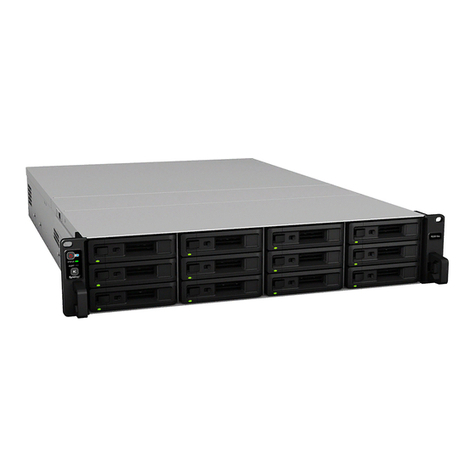
Synology
Synology RackStation RS3618xs Hardware installation guide
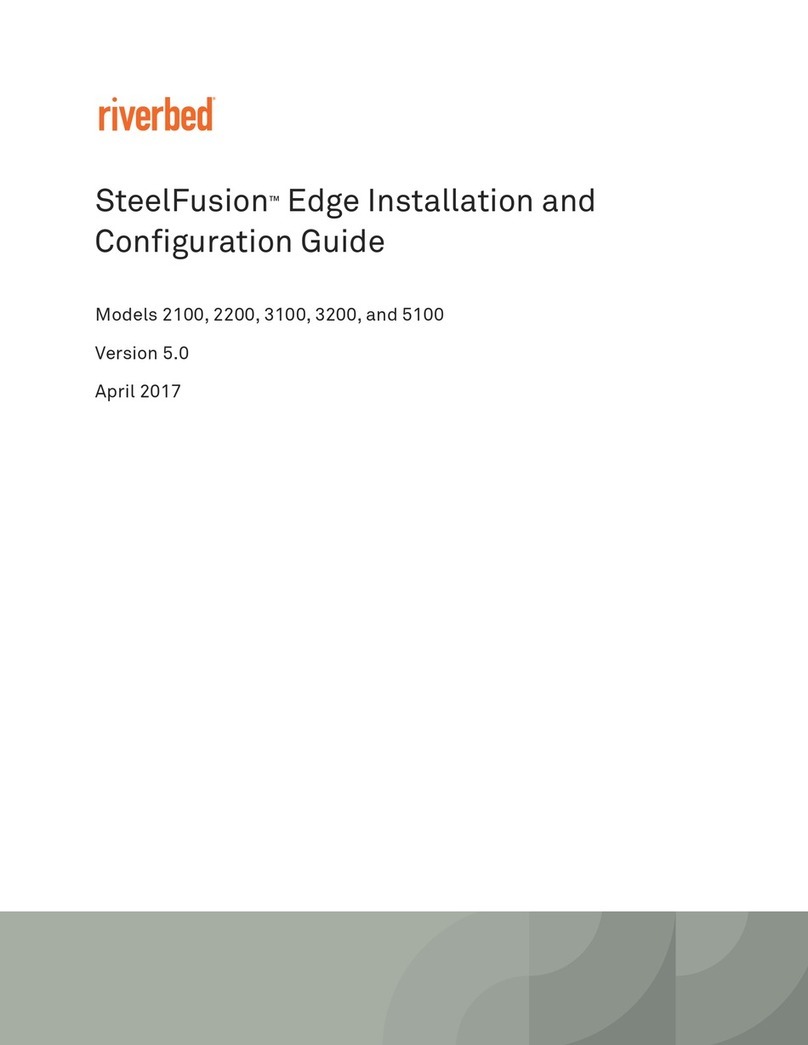
Riverbed
Riverbed 2100 Installation and configuration guide
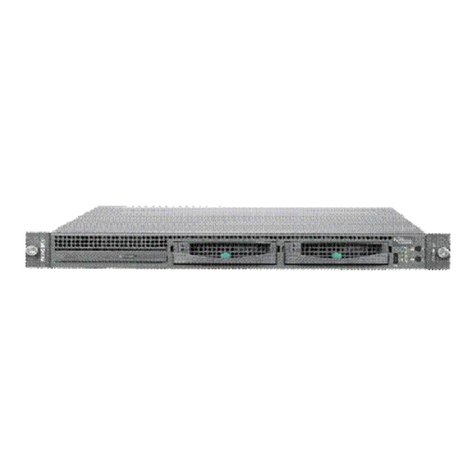
Fujitsu Siemens Computers
Fujitsu Siemens Computers Primergy RX220 Service supplement
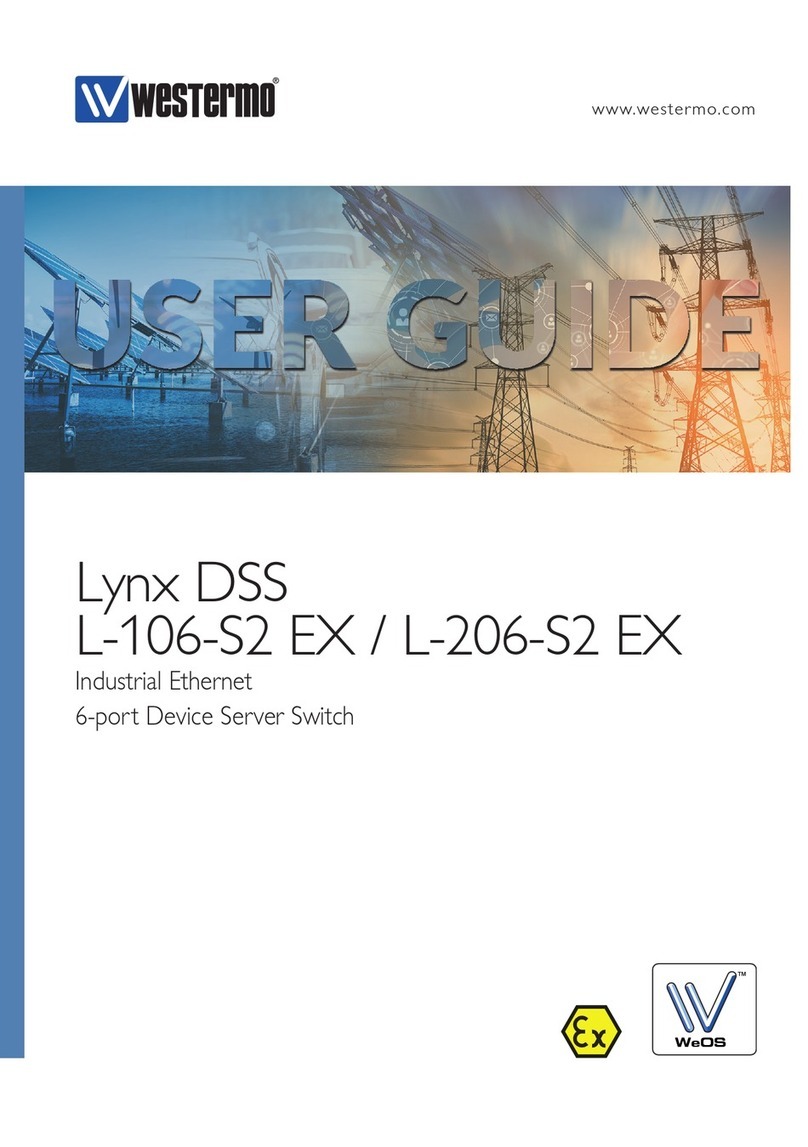
Westermo
Westermo Lynx DSS L106-S2 EX user guide

NEC
NEC NEC Express5800 Series Maintenance Guide
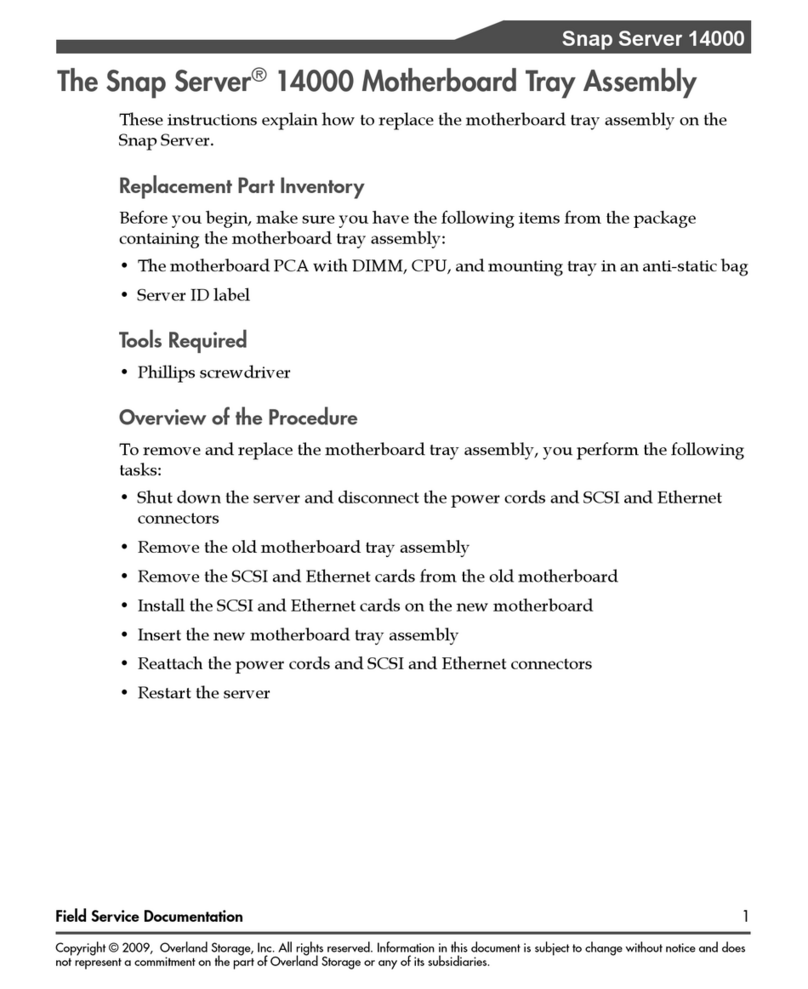
Overland Storage
Overland Storage Snap Server 14000 Assembly
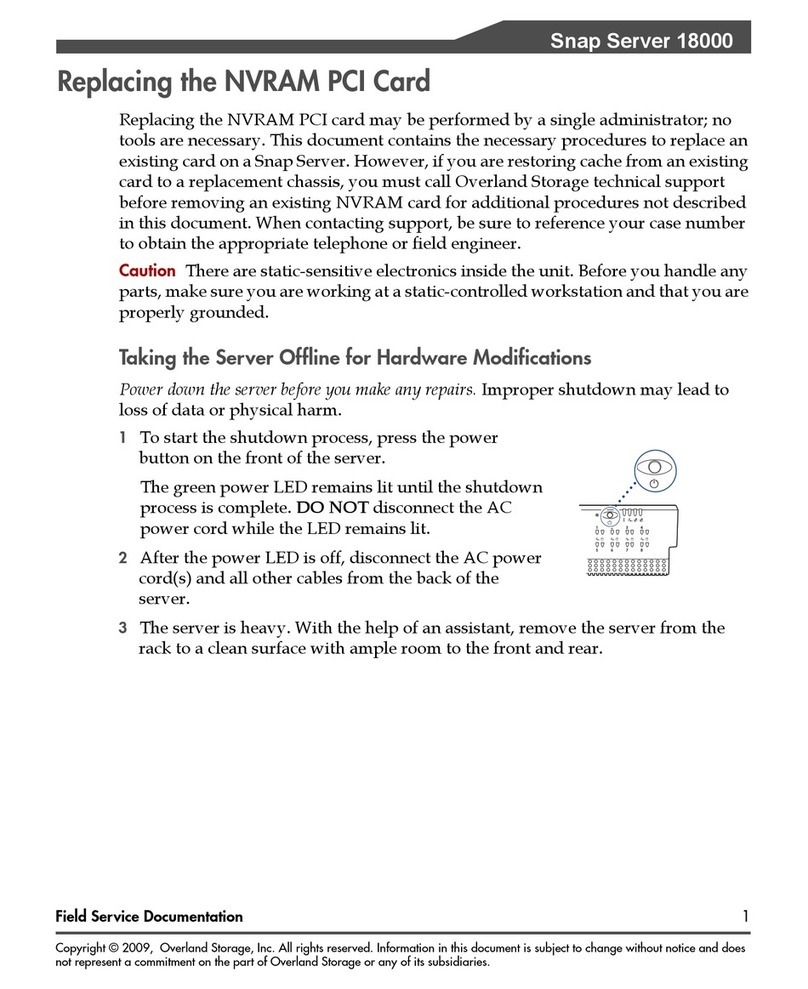
Overland Storage
Overland Storage Snap Server 18000 quick start guide
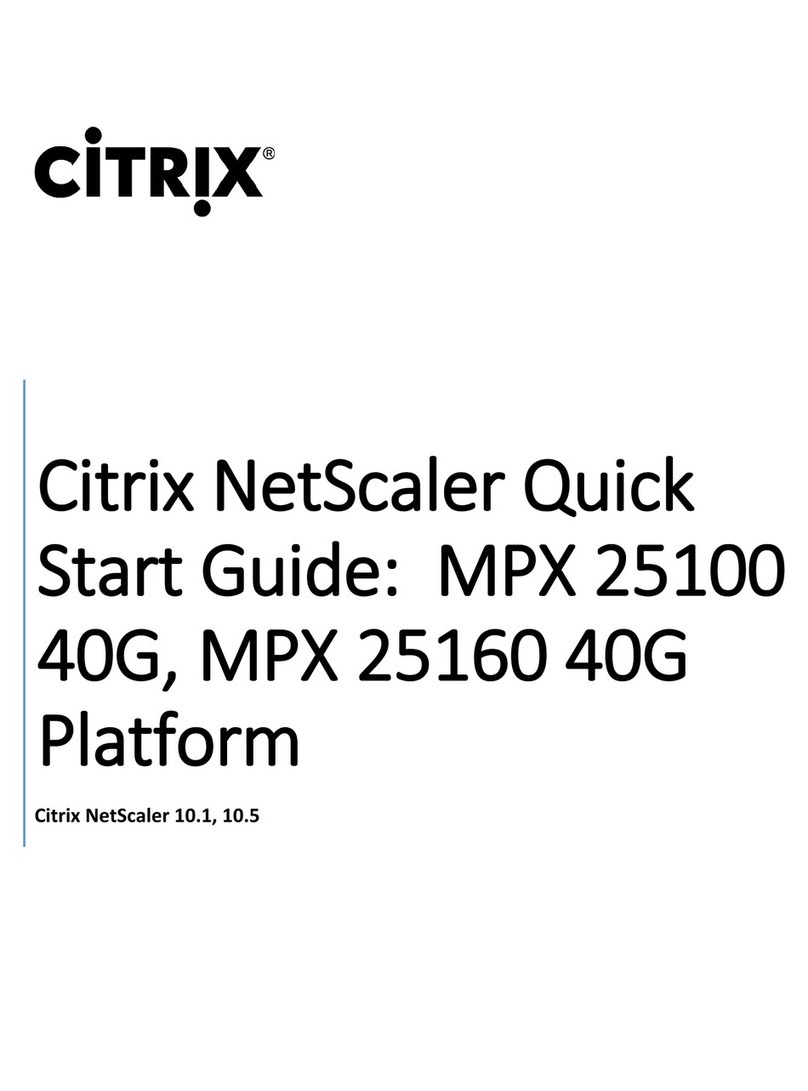
Citrix
Citrix NetScaler MPX 25100 40G quick start guide
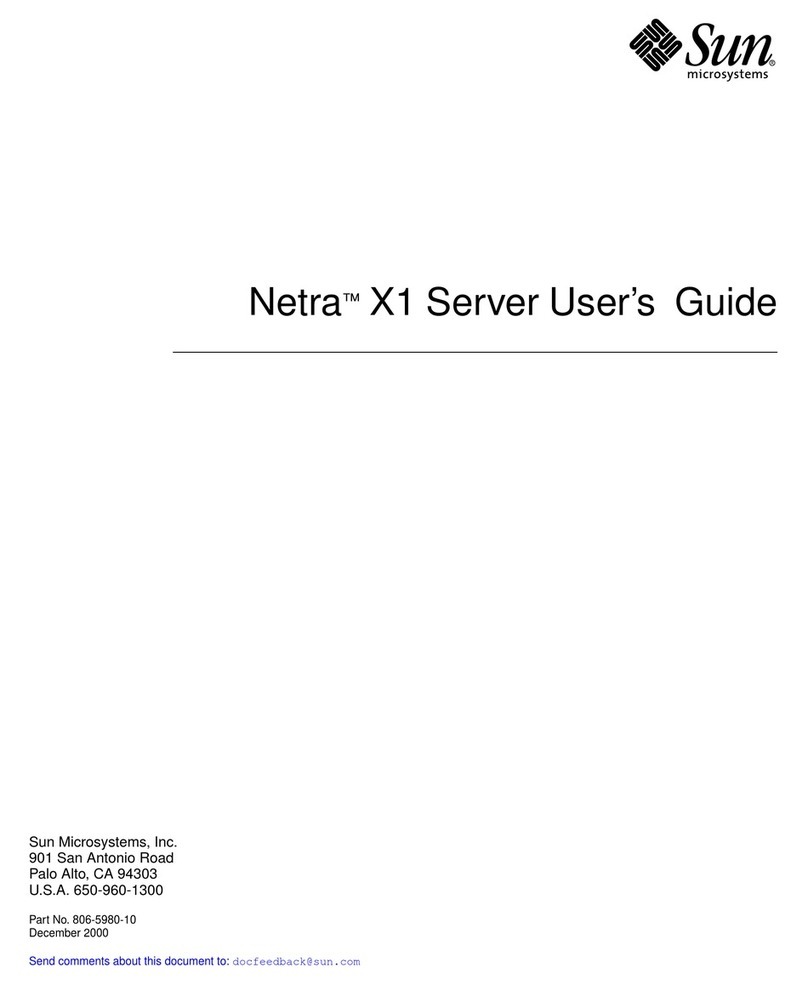
Sun Microsystems
Sun Microsystems Netra X1 user guide
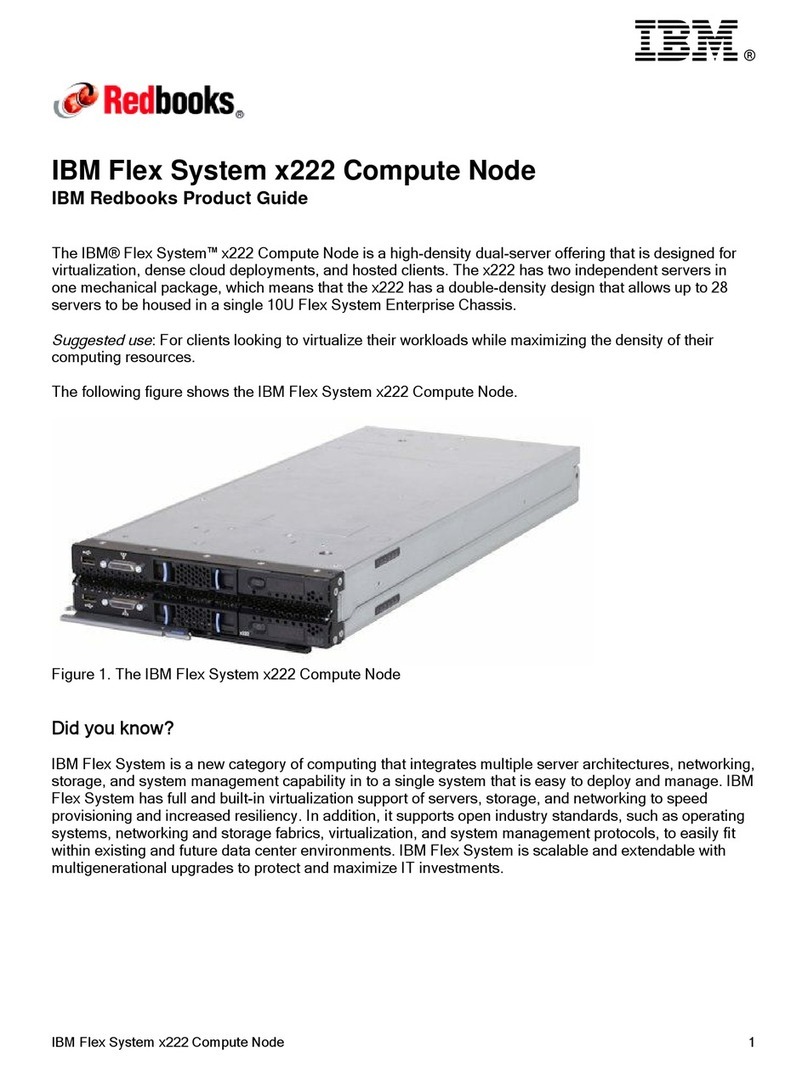
IBM
IBM Flex System x222 Product guide
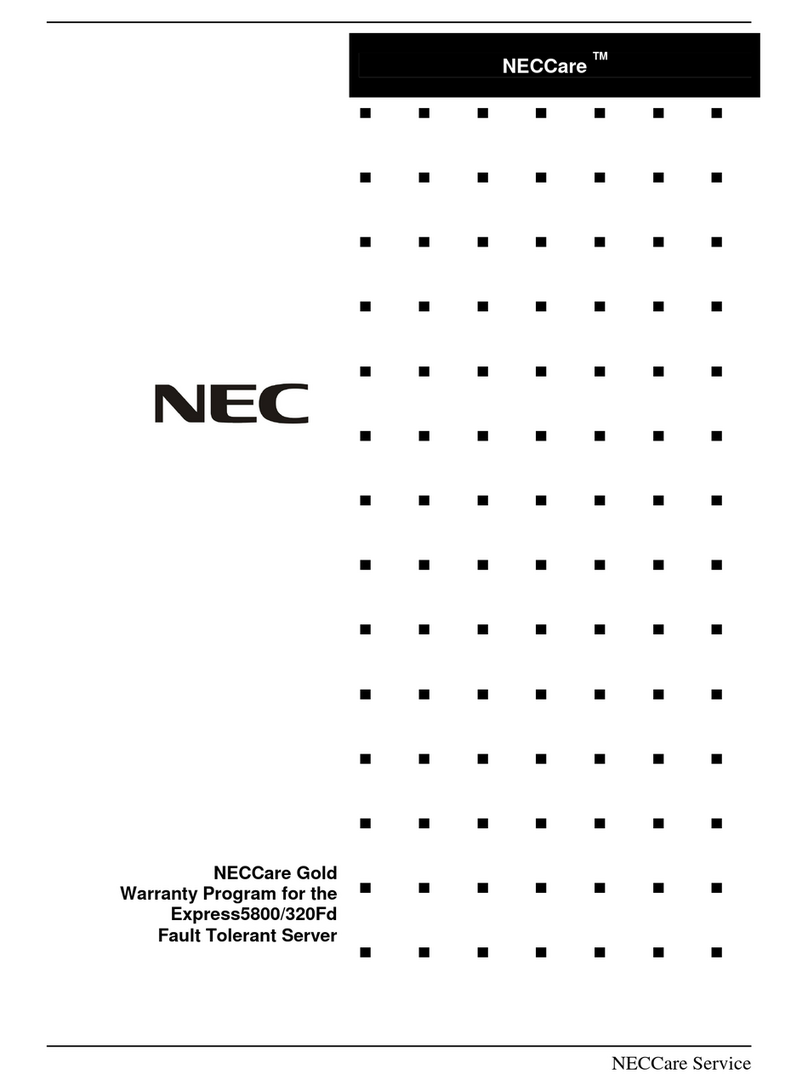
NEC
NEC NECCare Gold Express5800/320Fd Service manual


